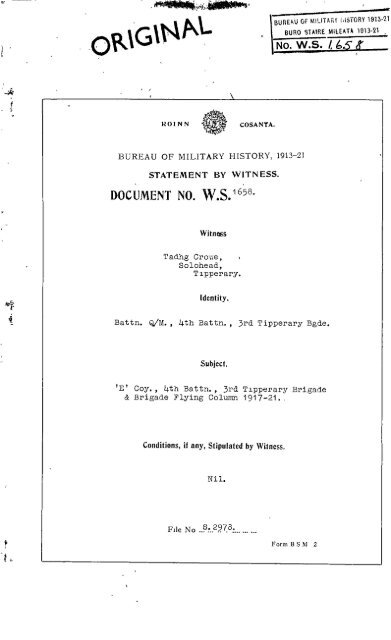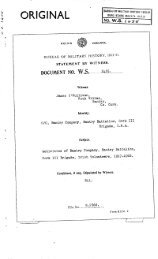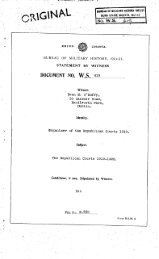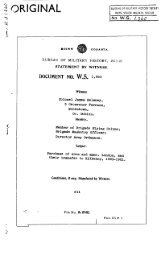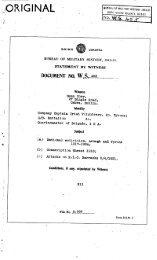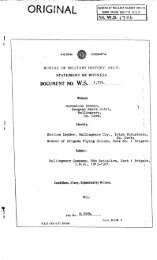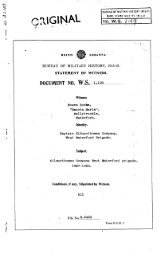ROINN COSANTA. BUREAU OF MILITARY HISTORY, 1013-21 ...
ROINN COSANTA. BUREAU OF MILITARY HISTORY, 1013-21 ...
ROINN COSANTA. BUREAU OF MILITARY HISTORY, 1013-21 ...
You also want an ePaper? Increase the reach of your titles
YUMPU automatically turns print PDFs into web optimized ePapers that Google loves.
<strong>ROINN</strong><strong>COSANTA</strong>.<strong>BUREAU</strong> <strong>OF</strong> <strong>MILITARY</strong> <strong>HISTORY</strong>, <strong>1013</strong>-<strong>21</strong>STATEMENT BY WITNESS.DOCUMENT NO. W.S. 1658.WitnessTadhg Crowe,Solohead,Tipperary.Identity.Battn. Q/M., 4th Battn., 3rd Tipperary Bgde.Subject.'E' Coy., 4th Battn., 3rd Tipperary Brigade& Brigade Flying Column 191 1917-<strong>21</strong>.Conditions, if any, Stipulated by Witness.Nil.File No S.2978.Form BSM2
STATEMENT BY MR. TADHG CROWESolohead,Tipperary.(Formerly Quartermaster, 4th Battalion, 3rd TipperaryBrigade).I was born in the year 1898 in the parish of Solohead,about four miles from Tipperary Town. My people were farmersand I, too, having completed my schooldays, settled down tolife on the farm with my parents and other members of my family.In the early months of 1917, the late Sean Treacy askedme to become a member of the Irish Volunteers. I agreed and,at his request, I got two others in the parish, my cousinJoe McCormack, and Thomas Ryan, to join. From threewe built our strength up to eight and Sean Treacy came alongon one or two nights each week and drilled and trained usat: an old fort in a grove near Limerick Junction. That wasthe beginning of what later became E/Company, 4th Battalion,3rd Tipperary Brigade.Secrecy was then the golden rule in all matters relatingto the Volunteers. Quietly we built up the strength to 20and later to 63. Sean Treacy conducted an election of companyofficers at which both he and I were proposed for companycaptain. Sean was then recognised as Volunteer organiser andleader in South Tipperary, but he was a man who would neverseek rank. He allowed his name to go forward simply becauseit was the correct thing to do and to comply with the generalrule of the members' right to elect their own officers. Forthe purpose of the record I will mention that I beat him bythree votes, 33 to 30.In August 1917, after his election as Sinn Fein M.P. forEast Glare, Eamon de Valera visited Tipperary Town on a Sundayand addressed a great gathering of people in the Sportsfield.
2.His visit coincided withthedeath of Most Rev. Dr. O'Dwyer,Bishop of Limerick, and de Valera paid tribute in his addressto the patriot bishop.At that time, the British authorities had proclaimedmarching in military formation, carrying hurleys and thewearing of Volunteer uniform. All three proclamations weredefied on that day. Volunteers carrying hurleys marched inmilitary formation to the Sportsfield and those who possessedwore them. Ouruniformscompany marched in from Soloheadand, as we entered the town, 'separation' women and Britishsoldiers' dependants flung rotten eggs and various classesof filth and dirt at us. We had a bit of a scuffle with themand gave as good as we got. Otherwise the day passed offin an orderly and dignified manner. The R.I.C., apparentlyconsidering discretion the better part of valour, made noattempt to interfere with the parades.Sean Treacy was arrested a few days after this meetingand Maurice Crowe, later battalion and brigade adjutant,frequently came out to Solohead to conduct the training ofthe company. From then until the conscription crisis periodpassed in the autumn of the following year, parades were heldpublicly and in defiance of the R.I.C.Sean Treacy served his term of imprisonment and returnedto continue his Volunteer work in the area towards the end ofNovember 1917. The crops on his farm at Soloheadbeg wereharvested and saved during the autumn by Volunteers who gavetheir time freely and willingly. He was, however, re-arrestedon 28th February 1918 and taken to Dundalk prison. Heimmediately went on hunger strike. We learned in Tipperarythat plans for his rescue were afoot and Maurice Crowe andDan Breen left for Dundalk. I followed on the following day,staying overnight in Dublin. On the train journey from
3.Dublin to Dundalk I had as a travelling companion a young ladywham I did not then know.On atrival in Dundalk, I met Maurice Crowe, Dan Breen andFrank Thornton who was there from G.H.Q., and learned from themthat, as Treacy and his two fellow-prisoners- Michael Brennanof Glare, and Seumas O'Neill of Cashel - had been granted theirdemand for treatment as political prisoners, the hunger strikewas over and it was not proposed to proceed any further withthe plans for the rescue. I called to the prison to visitSean and, to my surprise, who was there, concluding a visit tohim, only my lady travelling companion. She was a Miss MayQuigley and was then, or later, engaged to Sean. Breen,Maurice Crowe, Nicholas Treacy (Sean's cousin, who had alsotravelled up from Tipperary) and I spent that night withfriendly people named McQuill in Dundalk. On my way back,I remember buying a revolver holster and belt in a shop inCapel St., Dublin.The conscription crisis period followed almost immediately.The battalion organisation had by that time been introducedand our battalion, based on Tipperary Town, comprised tencompanies, viz: A and B -Tipperary Town; C -Donohill;D -Donaskeigh; E -Solohead; F -Bansha; G -Aherlow;H - Mount Bruis; I -Lattin, and K - Kilross. During thatperiod, from April to October 1918, each company sent two meneach day to the Volunteer Hall in Tipperary Town for 24 hoursduty. These 20 men used the Volunteer Hall as a guardroom.They were armed with a miscellaneous selection of revolversand one rifle which was kept in the Hall. In relays, onbicycles, they kept the military barracks, the militaryhutments and the R.I.G. barracks under continuous watch, dayand night, and reported any unusual enemy activity. Sean Duffythe battalion commandant, appointed Sean Carroll a full-time
4.officer in charge of the Hall and of the scouts.Carroll gave up his position in a drapery firm in thetown to attend to this duty.I usually at that time paraded the company outsidethe church gates at Solohead on Sundays after Mass. OnSunday, 2nd June 1918, a force of armed R.I.C. came outfrom Tipperary and asked me to cease what they termedillegal drilling. When I refused they appealed to thepriest and to an influential Co. Councillor to get me todismiss the parade and so avoid trouble. We continuedto ignore them and the police then used the butts oftheir rifles. We were unarmed and had only our fists;so, seeing that the battle would probably go against us,I ordered the men to disperse. When the excitementdied down I went home.Two mornings later, on Tuesday, 4th June1918,JunctionR.I.C. raided my home and took me to Limerick R.I.C.thebarracks and thence to Cork Prison. One week later,I was brought to Dundrum and tried at the Petty SessionsCourt and sentenced to three months imprisonment on eachof two charges-illegal drilling and wearing uniform,the sentences to run concurrently. Then Iwas broughtback to Cork Prison and from there to Belfast to servemy S entence.There were about 200 prisoners from various parts ofIreland in Belfast prison- all on political charges-when I was brought there. Amongst them were the lateAustin Stack of Kerry, Frank McGrath of Nenagh, MichaelKirby of Tipperary and the late Kevin O'Higgins.Austin Stack, as the prisoners' spokesman, demanded thatwe be treated as political prisoners, but the demand wasrefused. As a protest, and to enforce the demand,
6.to raid for me again. That meant that I had to go on the runand I spent most of my time away from home, especially at nighttime. Dan Breen and Sean Treacy were then also on the run, andBreen and I spent some weeks together on organising work in thecompany areas. It was, too, in October 1918, that the SouthTipperary Brigade was officially formed at a meeting ofbattalion officers which was held in P.J. Moloney's house inChurch St., Tipperary, and at which Dick Mulcahy presided.I was present at the meeting but, not being then a battalionofficer, had no vote. The brigade officers elected were:Brigade Commandant - Seumas Robinson; Brigade V/Commandant -Sean Treacy; Brigade Adjutant- Maurice Crowe; Brigade Q.M.-DanBreen.Later that year, Treacy and Breen set up, whet I might call,their headquarters in an unoccupied house, commonly known asthe "Tin Hut" on Hogan's farm at Greenane. It was, roughly,about four miles from my home in Solohead and about half a milefrom Sean Treacy's farm at Soloheadbeg. As I have said,they were both on the run at the time, and they were continuouslyengaged on Volunteer work.It was probably about the second week in January 1919,that Treacy told me of his intention to seize a consignment ofgelignite which was due for delivery at Soloheadbeg quarryand informed me that I was one of the men he had selected tocarry out the operation. The Quarry was worked by the CountyCouncil who had it on lease from the owners. The date on whichthe gelignite would be delivered from Tipperary militarybarracks and the strength of the R.I.C. escort which wouldaccompany it were uncertain.On Tuesday, 14th January 1919, I attended the fair inTipperary Town and called on Maurice Crowe, the brigade adjutantand collected from him some ammunition for a .45 revolver whichI had at the time. In accordance with Treacy's instructions,
7.I reported that night at Mrs. Breen's (Dan's mother) cottageat Donohill. I met Breen and Treacy there and the three of uswent to the "Tin Hut" at Greenane. We were joined at the Hutduring the night by Seamus Robinson and Sean Hogan. MauriceCrowe, Patrick McCormack (then an Irish teacher in Dundrum),Paddy O'Dwyer from Hollyford, Michael Ryan, Arthur Barlow andCon Power reported next day. During the days that followedthere were some changes in the personnel. On account of theirbusiness in life, some were unable to remain for more than a'day or two and then there were days when Brian Shanahan, NedO'Reilly, Dinny Lacey and Sean O'Meara were with us.The plans were simple enough. Each morning, two of theparty left to scout for the coming of the Co. Council men andthe police escort with the gelignite, and the remainder of uswent to the, ambush position. Two, positions were actuallyoccupied. For the first few days we waited at a point about200 yards from Coffey's forge. Then, one day, an R.I.C.man with a dog passed along the road and his dog ran into thefield where we were. As there was a likelihood that thepoliceman might have seen us, we changed the waiting positionto one about 150 yards from the entrance to the quarry. Therewe had reasonable cover behind a whitethorn hedge atCranitch's field, and there, too, a gate gave easy access onto the road. Wednesday, Thursday, Friday and Saturday morningpassed with the same routine, but nothing unusual happened.We returned each evening to the "Tin Hut", lighted a fire andspent the night there. In our conversations around the fire,there were divergent views as to what the strength of theescortbe, and variouswouldsuggestions were made about thebest method of holding them prisoners after they were disarmedand until the gelignite 'gas got safely away. We assumed allalong that the police would surrender when called upon to halt
8.and put up their hands, and I am certain that none of us contemplatethat the venture would end in bloodshed and loss of life.On the Saturday evening I returned home for a change ofclothing and on Monday morning we resumed the vigil; again, nethnothing happened. About midday on Tuesday, <strong>21</strong>st January 1919,Paddy O'Dwyer cycled back along the Donohill road from Tipperary,where he had been scouting,with the news that a horse and cart,with the gelignite, had left Tipperary military barracks4and that it was coming by the Boherfrimeroad. It was accompaniedby James Godfrey, driver of the horse and cart, a Co. Councilganger named Patrick Flynn and two R.I.C. men - ConstablesO'Connell and McDonnell. We moved into our pro-arrangedpositions and, almost immediately, Michael Ryan reported thatthe cart and its escort were approaching.There were eight in our party that day, viz; Sean Treacy,Seamus Robinson, Dan Breen, Paddy O'Dwyer, Michael Ryan,Sean Hogan, Patrick McCormack and myself. Some of us were armedwith revolvers, and Sean Treacy had a small automatic rifle.I had my .45revolver and my position was about 12 or 15 yardson the right of the main party. My instructions were to preventthe escort and the Co. Councilmen from running back alongthe road when the order to halt was given.After our week's wait, the whole affair ended suddenlyand in a tense atmosphere. My recollection is that the twoR.I.C. men armed with carbines were walking behind the horseand cart when it came into the ambush position. There wereseveral shouts of "Hands up!" I myself shouted that commandat least two or three times. I saw one of the policemen moveup to the cart and crouch down beside it. From the positionhe took up and the manner in which he was handling his carbine,I was satisfied that he was going to offer resistance. We hadinstructions not to fire without orders from Sean Treacy or
9.Seamus Robinson, but, as far as I could judge, the cart and theboxes of gelignite on it were shielding this policeman fromtheir view. I fired three shots at him; one wasineffective,and the other two hit him in the arm and back. About the sametime, either one or two shots were fired from the, gate whereSean Treacy was positioned, and the other constable fell,shot through the temple.We got out on to the road. The two constables were deadand Flynn and Godfrey were unscathed, but badly frightened.Dan Breen and I took the belts with the pouches of ammunitionand handcuffs off the dead policemen. Treacy, Breen and Hogandrove away on the horse and cart with the gelignite, andPaddy O'Dwyer and I took the R.I.C. men's carbines and hid themtogether with the belts, pouches of ammunition and handcuffsin a ditch about half a mile from the scene of the ambush.O'Dwyer and I then parted, he to go back home to Hollyford,and I went to Doherty's of Seskin.After having some tea in Doherty's, I returned home andtold my father that he might expect raids by the police. Infact, I told him exactly what was after happening. We discussedthe matter for a few minutes and he advised me to go away atonce, but warned me against staying in the houses of relativesas, he said, if the police were looking for me the; would besure to trace and raid the homes of all our relations.I stayed that night with two old men, very distantrelations of my family, and, next day, I went back towards myhome. My sister met me near the house and brought me some food.She told me that R.I.C. men from Tipperary had raided the houselooking for me at about 6 p.m. on the previous night, and thatmy father had told them I was not back from the fair inMitchelstown. They raided again, she said, about midnightand again in the early hours of that morning. That newsdispelled any thoughts I may have had about returning homeand I continued on the run for the following years untilthe Truce came in July 19<strong>21</strong>.
10.Shortly afterwards, on a Saturday night, Maurice Crowe,the brigade adjutant, found me at Patrick Merrick's house,Ballynonty, Cullen. He was anxious about the safety of thecarbines which we took from the police, so we went to Solohead-begand retrieved them from their hiding place. Mauricebrought the carbines, belts, pouches of ammunition and handcuffsto his people's place at Glenbane where Maurice's brother, Edmondcared for them until they were handed over to Dinny Lacey, Q.M.4th Battalion. One of the carbines was later allotted by thebattalion to the Solohead Company and I used it whilst with thecolumn in an ambush in the Glen of Aherlow.During the years I spent on the run, I rarely left Soloheador the neighbouring parishes and stayed with friends indifferentplaces. until the formation of the flying column inSeptember 1920. Tommy Ryan acted as company captain, but Irarely missed the Battalion Councilmeetings. Raids by thepolice and military on my home and on the houses of neighbourswere frequent butj was fortunate enough to avoid capture.On the night of 4th June 1920, an attempt was made tocapture Cappawhite R.I.C. barracks. Cappawhite was in the EastLimerick Brigade area but bordered on our area Sand we wereasked to co-operate. We blocked the roads leading fromTipperary, and Tommy Ryan, Jim Kilmartin and I went toCappawhite bringing with us a bag of 'mud' bombs which had beenmade from some of the gelignite captured at Soloheadbeg:On the same night, the 3rd Tipperary Brigade were engaged inthe attack on Drangan Barracks and practically all the "BrassHats" were gone there. Jim O'Gorman from Hollyford and DinnyLacey were amongst those whom I remember as having been withus to Cappawhite.The attack started about midnight and followed the usualpattern of barrack attacks at the time -holding the police inthe barracks with rifle and shotgun fire and forcing them to
11.to surrenderby setting fire to the roof. Jim O'Gorman used aladder to reach the roof, but, try as he would, he failed toset it on fire. He made several attempts at it with oil andmud bombs, but without success. After a few hours, it becameapparent that the garrison would not surrender and it wasdecided to break off the attack. Dinny Lacey, Sean Stapletonand I remained there until daylight- some time around 4.30at intervals to the policemen's fire from the barracks.replyinga.m.We had one casualty that night- a Volunteer named Tadhg Hoganbeing wounded. Some of the Donohill Company who were on dutyon road blocks had a fight that morning with military fromTipperary who were going to the relief of the barracks.Shortly after that, I fell seriously ill with doublepneumonia and was nursed over my illness at Rafferty's ofAcroboy. It was my second time to have pneumonia and itaffected my health for many months to come. I was recuperatingat Rafferty's when Sean Treacy and Ned O'Reilly arrived thereto make it their H.Q. on the eve of the Oola ambush, so I movedto Quinn's of Ballycohey.That ambush at Oola took place on 30th July 1920. Itarose from a report by the Solohead Company that a lorry ofmilitary carrying mails and preceded by a motor cyclist passedregularly along the Tipperary-Limerick road, and Sean Treacydecided to ambush it. Jim O'Gorman and Michael Fitzgeraldcalled to Quinn's for me after the ambush and told me whathappened. The motor cyclist did not pass and the lorry, whenit came, was fired on by the main party. This lorry was closelyfollowed by a second lorry of military who dismounted and tookpart in the fight. After the first volley it was found thatthe ejectors of the Martini rifles which the main party wereusing failed to eject the empty cases from the breech, dueperhaps to incorrect ammunition being used. There was thenno option but to break off the engagement and Treacy, they said,
12.saved the day, as he kept the soldiers pinned down on the roadwith rapid fire from his parabellum whilst the main partywere withdrawn, Later, we learned that two British soldierswere killed and three wounded and that General Lucas, who hadescaped from I.R.A. custody on the previous night, was in thelorry, having been picked up by the military at Pallas.From Quinn's we went back to Rafferty's of Acroboy andlater, to O'Dwyer's of Ballananstown. The owner of this housewas a brother of Sir Michael O'Dwyer of India and Punjab famebut we were made welcome and given chicken for our supper.The brigade flying column was established in September1920, and assembled for the first time at Barlow's of Shrough.Its initial personnel were: Sean Hogan, Dinny Lacey and PaddyMoloney, battalion officers; Michael Fitzpatrick and Jerry Kielyof A/Company; Torn Bellew and Martin (Sparky) Breen of B/Company;Brian Shanahan and Pake Ryan of D/Company; Tadhg Crowe (self)and Michael (Booleen) Ryan of E/Company; Matt Barlow and PakeDalton of H/Company; John Joe O'Brien, Sean Wnch and BillFraher of Galbally, making a total strength of 16, and laceywas appointed 0/C. pro tem.The column moved into the Glen of Aherlow where a periodof training was done. It took a while for the people amongstwhom we billeted to become accustomed to having armed mentraining and wandering around in their midst. However, whenthe first shock of surprise wore off, they welcomed us andcatered for us with a will. At Grantstown we were joined bya party of nine men from the 3rd Battalion which included NedO'Reilly, Jim O'Gorman and my old friend of Soloheadbeg, PaddyO'Dwyer. A meeting of the column to elect a permanent columnleader was held at Grantstown. Seamus Robinson, the Brigade0/C., presuded and there were two proposals-Dinny Lacey andNed O'Reilly. Lacey was elected with the support of the 4thBattalionmen.
13.Next came the shock of Sean Treacy's death in Dublin.I remember Dinny Lacey and I were in Lattin when Sean Hogancame and told us the sad news. That was probably on October15th, for Sean was killed on 14th October 1920. On the dayof his funeral, Lacey and I watched the funeral cortege froma field at Barronstown Cross, near Limerick Junction. Weknew that military had interfered with the funeral arrange-mentsat Solohead Church and we saw another party of militaryseize the bicycles of some of the mourners. In view of allthe enemy activity that was going on, we reluctantly decidedthat it would be unwise and foolhardy for us to follow theremains to Kilfeacle Cemetery.The first engagement between the column and enemy forcestook place at Thomastown - about midway between Tipperaryand Cashel - on October 28th, 1920. About 9 a.m. thatmorning, we prepared and occupied a position to ambush atender of Black and Tans from Golden, but a lorry conveyingabout 20 soldiers to the rifle range in Tipperary arrivedand we ambushed that instead. My recollection is that thelorry slowed up and then stopped before it came into theambush position proper, with the result that some of our menhad to crawl behind the wall to get a position nearer to thelorry. Meanwhile, the soldiers were dismounting and takingcover and we had lost the element of surprise. The militaryofficer in charge of the party either wore armour or bore acharmed life. He was firing with revolvers from the bonnet ofthe lorry and Jim O'Gorman lobbed the only grenade wepossessed over the wall and quite close to the lorry, but itfailed to explode. Ned O'Reilly and O'Gorman - both crack sheshots - fired at him from the road but, as far as I could see,withouteffect.The firing lasted, I would say, for 8 or 10 minutes.One of our men - Michael Fitzpatrick- received a serious
14.wound in his thigh and had to be helped away. Hew as our onlycasualty. Lacey then decided to break off the engagement. Asthe ambush position was on the main Cashel-Tipperary roadthere was a grave danger of further enemy forces arriving, andthe column, with the exception of two men who were assistingMichael Fitzpatrick, withdrew to Dranganmore. This movemententailed crossing the road to the Grantstown side and was carriedout under cover of a rapid fire from four or five members of thecolumn who occupied a position behind a quarry on that side ofthe road. The British casualties were, I believe, five soldierswounded. There were rumours, too, that the officer died a fewdays later from wounds received at Thomastown, but that, I think,was never confirmed.Following the engagement at Thomastown, the nine men from the3rdwho hadBattalion,joined us at Grantstown, returned to theirown area to operate as a separate unit.The next clash between the column and enemy forces tookplace on Saturday evening, 13th November 1920, at Lisnagaul,about three miles from Bansha in the Glen of Aherlow. We hadoccupied the position at Lisnagaul on three consecutiveSaturdays to ambush a mixed party of R.I.C. and Black and Tans.This was a pay party which usually travelled on Saturdays in aCrossley tender and paid the forces at Emly, Galbally andBansha before returning to Tipperary town.On the first two Saturdays the pay party did not come, orat least, it did not travel via the ambush position at Lisnagaul.On the third Saturday it came in the afternoon. Including thedriver of the tender, the party consisted of eight R.I.C. menand Black and Tans. No barricade was placed across the road and,at his own request, Richard Burke, 0/C. Aherlow Company, wasgiven the task of stopping the tender. Burke was armed with adouble-barreled shotgun and at his first shot the steering wheel
15.flew out of the driver's hands and his second shot got thedriver on the arms and hands. The tender hit the ditch andstopped. Almost simultaneously the main party opened fire andthere was a sharp encounter at close range with some of thepolice who had taken cover underneath the tender. Thatcontinued for perhaps five or six minutes until the policeshouted that they were agreeable to surrender. On going outon to the road we found that three of the policemen were deadand the four who surrendered were all wounded. One policemanhad jumped from the tender and escaped when the firing startedand I understand he reached Bansha safely.We collected the rifles, revolvers and ammunition belongingtothe dead and wounded policemen. In addition, there weresome spare rifles and a box of .303 ammunition in the tenderall of which made a welcome addition to our meagre supply.Finally, we used some spare tins of petrol which were on thetender to spray it and set it on fire, having first removed itthebodies ofdead policemen from its vicinity.The British reaction to the ambush at Lisnagaul took theform of reprisals. Three shops in Tipperary town -P.J. Moloney'sHayes in Main St. and the Irish House - were wrecked and lootedand military and police who visited the scene of the ambushburned down a nearby Co. Council cottage.After Lisnagaul, ambush positions were occupied for twodays on the Tipperary-Emly road and on the Tipperary-Dundrumroad, but without any fight, as no enemy forces arrived. Oneof the big difficulties about remaining for lengthy periods inan ambush position, especially on main roads, was the numbers ofpassers-by, such as people going to the creameries, or countrygoing peopleto the towns, who, with their vehicles, had to betaken in off the road and detained. The longer we remained inthe position the greater was the number to be detained, and Iremember on one occasion a band of tinkers came along and had tobe detained with the others for the length of a day.
16.The column disbanded for a few days around Christmas, 1920.I did not go home, but spent the break resting at Cronin'sof Monamore, near Solohead. I had never completely recoveredfrom the pneumonia which I had earlier in the year and I rememberI felt very sick again about the time the column disbanded.On Friday, December 28th, I went to O'Doherty's of Seskinwhere the column was due toreassemble. Dinny Lacey, SeamusRobinson, Jim O'Doherty and Jack O'Meara were in O'Doherty'swhen I arrived and the remainder of the column were scatteredin other houses around Seskin. The five of us had dinner andRobinson retired to the parlour to do some writing. Next, weheard the screeching of brakes and a lorry of Black and Tanspulled up at the gate and approached the house. After a briefperiod, whilst Robinson collected his papers, we rushed out ofthe house and a running fight developed. Our route brought usparallel to the road and also parallel to a river which wasswollen.A second lorry of Black and Tans arrived and drove alongthe road, apparently with the object of heading us off. Wewere in a tight corner between the road and the river, and wewould have to leave any cover we had if we went towards theriver and tried to cross it. Jack O'Meara did go for the riverand succeeded incrossing it, and his run drew the Tans who hadarrived in the first lorry after him. Jim O'Doherty and I knewthe district well and we took Robinson and Lacey along a linewherewe would have cover. We had reached a point two fields frfrom the road when the Tans from the second lorry dismounted andentered the field beside the road. We engaged them from thedividing ditch. Things were far from rosy. Robinson had on apair of light shoes and slipped several times in the mud. Hewas armed with a parabellum pistol and he was handicapped withthe bundle of official papers which he carried under one arm.Jim O'Doherty's weapon was a Winchester .44 repeating rifle
17.for which he had only seven rounds of ammunition and, havingfired those seven, his gun became useless to us. Relief camein the person of Bill Fraher. He had been on his way toO'Doherty's house and, fortunately, had his rifle with himwhen he heard the shooting. He doubled to it, sized up thesituation and opened a rapid fire which scattered the Tansand we had no further trouble from them.We had, however, to keep going and we went in the Ooladirection. There were several bullet holes in Lacey'sclothing and a bullet had passed through my overcoat. On thejourney I started to cough up blood and some of the othershelped me along. It looked then as if my health had completelyfailed. That night, a reprisal party of British forces burnedO'Doherty's house and also burned hay at Jim Kilmartin's place.Jim Kilmartin was also a member of the column.Next day in Donaskeigh, Dan Breen gave me an address ofpeople in Co. Donegal to which I was to go to recuperate.Packy Deere, 0/C. Donaskeigh Company, and a cousin of SeanTreacy, who was also in bad health with rheumatic painswas to come with me. Tom Carew, the brigade Q.M., gave us £5 tocover our expenses. The column had reassembled and moved offand Deere and I went back to Solohead. There, I decided not togo to Donegal. I thought that if I was going to dieI would die at home in my native place, and Deere decidedthat he would not go either.In January 19<strong>21</strong>, I was sent to Dublin by Dinny Lacey tocollect and bring back some explosives and a plunger forexploding electrically fired mines which, I understood, wereto come from Scotland. My instructions were to call toCharlie McLaughlin's office at 8 Upper O'Connell St., where Iwould either be given the material or be put in touch with theman who was to hand it over. Lacey gave me 8/- going to covermy expenses and I travelled by rail on a privilege ticket
18.obtained by a cousin of mine who worked on the railway.I was warned under no circumstances to call in to PhilShanahan, whose place in Foley St. was then the meeting placeof Tipperary men in Dublin.On arrival in Dublin I went to a restaurant and ordereda substantial meal. To my amazement, it cost me 5/6, whichleft me almost broke. I found Charlie McLaughlin's place,but neither the stuff nor my man had arrived. I waited in anouter office until closing time when it was suggested I shouldcall back next day. I then strolled down Talbot St. towardsFoley St. in the hope that I would meet someone I knew. I wastempted to go in to Phil Shanahan's and explain my predicamentto him, but, in view of my strict instructions, I refrainedfrom doing so. I bought a loaf of bread with some of myremaining pennies in a shop near Shanahan's, and then twodetectives came along. Seeing my bulging pocket, they stopped,tapped me all over and asked me where I was from and what Iwas doing in Dublin. I told them I was from Limerick and thatI had come to Dublin in the hope of finding work. They saidthere were no jobs to be had in Dublin and to get out of thecity as quickly as I could. They were very stiff at first,but the sight of the bread in my pocket softened one of theirhearts, for he put his hand in his pocket and gave me 2/-,saying that that was all he could afford as he had justreturned from a period of leave in Co. Mayo.I wandered off through the city and out of it. It iasa dark cold night and the curfew hour was approaching. I spoketo a night watchman and hoped that he would permit me to remainwith him at his fire, but he told me to move on as they werechecked up on during the night. I eventually spent the nightin a group of buildings which was under construction. I hadno idea, no more than the dead in their graves, of where I was
19.When daylight came next morningsecond anniversary of Soloheadbeg- it was <strong>21</strong>st January, the- I saw on a notice board"PeamountSanatorium".On my way back to the city I inquired the time from awoman at the gate lodge of the Ashtown Gate of the Phoenix Park.While Iwas speaking to her I gave a nervous start on seeing aparty of British cavalry pass on their way out of the park.She noticed it and said "Don't worry about them; they takethe horses out for xercise every morning". I felt miserableand must have looked it for she brought me in a gave me a cupof hot tea.I washed that morning in the underground toilet inO'Connell St. before calling again to Charlie McLaughlin'soffice, where I spent the day waiting in the outer office.Neither the stuff nor news of it arrived, so I returned by alate train that night to Limerick Junction after a fruitlessjourney and a night out for nothing.It is difficult now after such a lapse of time to recallall the various incidents of that period. I remember oneevening, about three weeks after my return from Dublin, I paidone of my infrequent visits to my home. While I was therea party of military, accompanied byan R.I.C. detective namedCarolan from Limerick Junction, arrived outside the house.I knew Carolan well and he knew me, but I also knew that hewas disposed to be friendly and not likely to identify me forthe military. I gave my revolver to my mother to hide itand walked out into the yard, where I was questioned by themilitary officer. As I expected, Carolan made no effort torecognise me, but went into the house with some of the soldiers.The officer was very polite and asked my name. I gave him mybrother's name, John Crowe. He said it was Tim or Tadhg Crowethey wanted, and inquired if I knew where he was. I replied
20.that we had not seen or heard of him for months. While thisconversation was going on, one of our horses strayed into theyard. I caught him by the mane and, breaking off the conversa-tionwith the officer, walked away, leading the horse, withoutbeing further challenged.About April 19<strong>21</strong>, I received orders from the battalion H.Q.to arrest a suspected spy named Jackson who lived in Tipperarytown, but was then working at his trade as a plasterer inSolohead. We arrested and detained him in a disused house inBallygodoon; he was then shifted to a dugout in Lattin and triedby a courtmartial of brigade and battalion officers. I was noton the courtmartial and cannot say what evidence was againsthim, but the court sentenced him to death and the findingsof the court were sent to G.H.Q. for confirmation. About aweek or more elapsed awaiting a reply from G.H.Q. who disagreedwith the court's findings and ordered the prisoner's release.On Saturday night, 30th April 19<strong>21</strong>, Sean Duffy, theBattalion 0/C., Patrick Maloney, the battalion adjutant, BrianShanahan and I brought Jackson from Lattin and released him atMonard Cross. He went on towards Tipperary Townandwe went toMartin Ryan's of Boherdota where the four of us stayed for thenight. On the next day, Sunday May 1st, after Mass inSolohead, Duffy and Maloney went to Maloney's uncle's place atGurthdrum. Brian Shanahan went to Seskin and I went to acousin's house for a change of underclothing. It was arrangedthat Shanahan and I would rejoin Duffy and Maloney at Gurthdrum jlater in the day.About dinner time that day, a party of police from Tipperaryraided Maloney's house. Sean Duffy and Paddy Maloney made aneffort to escape and had got some distance from the house whenthey ran into a second police party and an exchange of shotstook place which resulted in both Duffy and Maloney being shotdead. Shanahan and I were on our way to meet them when ithappened.
<strong>21</strong>.Next night, a party of police in civilian clothes calledagain at Maloney's of Gurthdrum. This time they took out oneof the workmen, John Buckley, and shot him. To make it lookitlike the work of the I.R.A. they put a label "Spies andinformers beware" on the dead body. Buckley was a member ofmy company in Solohead and there was no doubt about hisintegrity.Brian Shanahan was appointed battalion commandant insuccession to Sean Duffy. James Maloney, then the battalionQ.M., succeeded his brother Patrick as battalion adjutantand I was appointed to the battalionstaff.asquartermaster.Two other members of the battalion staff were Arthur Barbourvice-commandant, and his brother Matt, battalion engineer.The big trouble of a quartermaster's job at that time was toget anything in the line of warlike stores. Any little whichdid come my way was issued immediately to the columns.I am not sure of the date, but I think it was about thattime there was an incident involving the shooting of a Britishmilitary policeman. I remember Lacey's column were in Seskinand two of its members, Sean Downey and Bill Allen, weredetailed to go to Limerick Junction. If the opportunity arosethey would fire at any ef-the R.I.C. man or Black and Tan whomight be outside the barracks.' Seeing none of the latter,they decided to hold up and disarm this military policeman.Apparently he was not prepared to part with his r evolverlightly and, when he attempted to draw it, the boys fired onhim, with the result that he was shot dead. A chap namedJames O'Connell, a member of the Kilross Company, was arrestedand charged with the shooting. was He awaiting trial in CorkPrison when the Truce came and probably saved his life.The disbandment of the brigade columns took place aboutthe end of May or early in June 19<strong>21</strong>. The idea was that the
22.members of the columns should return to and form active serviceunits in their own battalion areas. The 4th Battalion men,after their return front service with the column, proceeded todo something about enforcing the boycott on Belfast goods andthey held up a goods train about one mile from Limerick Junction.The R.I.C. from Oola went out later to investigate and foundsome of the Belfast goods including whiskey which had beentaken from the train. The police returned to the barracks andenjoyed their booty. This. gave the boys the idea of staginganother train hold-up and to ambush the Oola police if theywent out again.I was not present when this ambush took place and in whichtwo policemen were killed and one wounded, and arms theandammunition of the police were captured. It took place aboutthe first week in July 19<strong>21</strong>, at Boherdota Bridge and, to thebest of my knowledge, Brian Shanahan, the battalion commandant,was in charge of the ex-column men and some members of theSolohead Company who had been mobilised for the occasion.There were various other incidents of that period whichhave escaped my memory, but I think I have dealt with thoseof primary interest.To conclude, it may be of interest to record that, shortlybefore the Truce, what was left of the gelignite taken atSoloheadbeg was used to destroy Ballydrohid and Aileen bridges.Ballydrohid bridge was blown up by the battalion staff, that isby Brian Shanahan, Arthur Barlow, James Maloney, Matt Barlowand myself. I was present, too, at the destruction of Aileenbridge. That was about a week before the Truce, and I may saythat I felt a sense ofrelief at seeing the end of thatgelignite. Its history and its hairbreadth escapes fromrecapture by the military and police after the Soloheadbeg
23.ambush are fairly accurately described in Desmond Ryan'sbook "Sean Treacy and the Third Tipperary Brigade", and,I might add, they were almost as varied and as excitingas those of any of the men who took it.Signed:TadhgCroweDate: 7the August1957Witness:Ggrace


